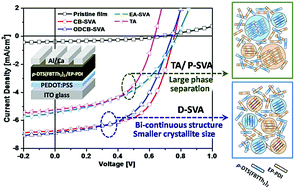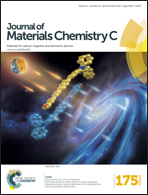A bi-continuous network structure of p-DTS(FBTTh2)2/EP-PDI via selective solvent vapor annealing†
Abstract
A critical requirement of small molecule non-fullerene acceptor-based solar cells for efficient charge separation and collection is the formation of interconnected phase-separated domains of 10–20 nm. The phase-separation behavior of small molecule donor 7,7′-(4,4-bis(2-ethylhexyl)-4H-silolo[3,2-b:4,5-b′]dithiophene-2,6-diyl)bis(6-fluoro-4-(5′-hexyl-[2,2′-bithiophen]-5-yl)benzo[c][1,2,5]thiadiazole) (p-DTS(FBTTh2)2) and acceptor N,N′-bis(1-ethylpropyl)-perylene-3,4,9,10-tetracarboxylic diimide (EP-PDI) was regulated by donor selective solvent vapor annealing (D-SVA), poor donor solvent vapor annealing (P-SVA) and thermal annealing (TA). It was found that the power conversion efficiency (PCE) was significantly improved from less than 0.2% up to 3.0% after D-SVA. In contrast, a limited improvement of PCE was obtained for P-SVA (1.9%) and TA (1.8%). The difference in the improvement of PCE values was attributed to the formation of a phase-separated structure and the regulation of crystallite sizes under different post treatments. The fibrous crystals of p-DTS(FBTTh2)2 were formed during D-SVA treatment while the EP-PDI component was in the form of small microcrystals, thus leading to the required interconnected phase-separated structure. As a consequence, the moderate phase-separated morphology accompanied by a pure crystalline phase with a medium size could maximize the carrier transport process without compromising exciton separation efficiency, and thus contributes to the final optimal PCE value of up to 3.0% under D-SVA. For P-SVA or TA treatment, we only observed a significant enhancement of the crystallinity of both p-DTS(FBTTh2)2 and EP-PDI components, leading to remarkable film coarsening, or even undesired large phase separation, which is detrimental to the exciton diffusion as well as exciton separation processes.


 Please wait while we load your content...
Please wait while we load your content...